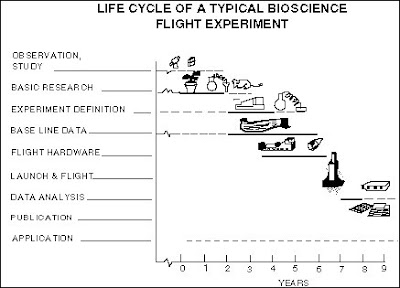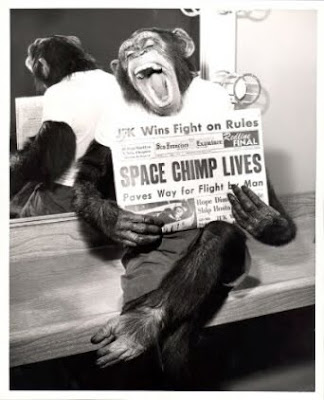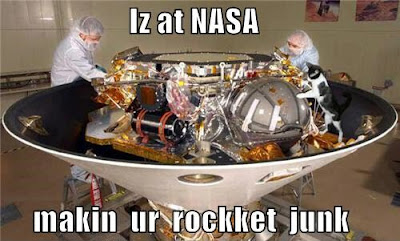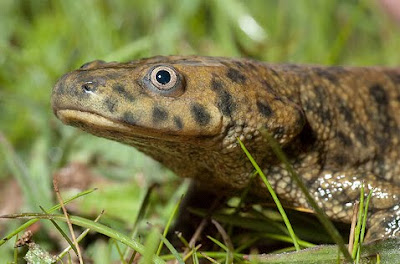
Preparing to write about "fish in space" brings back a personal, early-childhood memory for me. SF newscasts sometimes covered the goings-on aboard
Skylab, including a mention of the first mummichog minnows being cared for in the weightless environment by astronaut
Owen Garriott, who I thought looked like a country singer.
I pictured a colorful aquarium aboard
Skylab, but of course such a thing was impossible, so I was disappointed to hear about drab "bags" that enclosed the mummichogs. I asked my father:
"How do the fish know the difference, if they're in water? Don't they float anyway?"
John Boyd at Johnson Space Center,
choosing two Astro-fish and 50 eggs for Skylab in 1973
My Dad is one of those people who doesn't modify his speech depending upon the age of the audience. As far back as I can recall, he always answered me as if I was an adult, and there were never any shortcuts or mythology in his responses.
He repeated my question,
"Oh, can they feel anything particularly amiss, still being in water while being transported to micro-gravity?" Or something to that effect.
He explained that all creatures can feel the pressure of gravity, and would naturally be affected when there was suddenly no sense of "up" or "down." The same way humans re-orient themselves to any new environment, they would seek any familiar stimulus. In the case of the fish, I know now from NASA archives that
they initially looped, then swam toward any source of light, thinking that is where they would find the "surface" (despite that water in space always tenses itself into a sphere).
I'm sure I understood precious little of it back in 1973 from a scientific or evolutionary point of view, but I understood they were seeking the sun, which was always the light "above" them. That made sense. We were all learning together back then, astronauts and little kids alike.

The Amazing Mummichog
(Fundulus heteroclitus) – also known as killifish
Of course, we humans love to believe we are the most resilient animal who ever braved space, but we are slow to adapt in comparison to some of our fellow earthlings. Nearly four decades later, it might surprise many to know that
the "hardiest" animals in space have proven to be these first diminutive aquanauts!Cockroaches and Keith Richards have nothing on the tough mummichog minnow, which can cope with varying environments and even rapidly changing habitats that would easily kill other animals. While most fish are limited to particular ranges of salinity, mummichogs can survive in fresh water and all the way up to water with nearly half-a-pound of salt per pint. Yow!
Scientists have changed water temperatures, altered oxygen levels, diluted their blood chemistry, even polluted their tanks with toxic chemicals. Turns out these little guys are darned hard to confuse and even harder to kill, largely because they travel through fluctuating environments in the wild. Their systems always manufacture proteins that help them normalize within about 72 hours.

As an adult, I still wondered: are fish worth studying up there? What can marine animals teach us? Researching this concept with older eyes has been an amazing experience this week. I've read about 200 articles, and in terms of motion sickness, osteoporosis and inner-ear balance, here are some of the best
Fish Stories:
2005The European agency conducted a "
Space fish against osteoporosis" project (I love how they made it sound like the fish were in on it), whereby researchers cultivated fish embryos and studied the bone loss they experienced in weightlessness – about 1% per month, just like humans. Despite that one walks and one swims, they also noted "molecular and protein interactions"
are identical in fish and humans,
as are physiological bone-loading mechanisms regulated by gravity. Analysis of regeneration after they return to Earth is providing a model for developing therapies to increase bone density in osteoporosis patients.
2007A 3-litre tank holding
26 baby cichlids launched from Baikonur Cosmodrome aboard a Russian Foton-M3 craft. Scientists monitored the larval fish to examine the growth of their otoliths in microgravity, seeing if there were any fundamental changes in these small sensory organs that play a role in balance. Humans have similar otoliths, which are equally sensitive to gravity and acceleration; dysfunction in this delicate system can cause, balance disorders, vertigo or tinnitus.
Similar
NASA studies on both fish and humans (I was part of one of those… and I can tell you that weightlessness, even in simulations, puts your inner ear and balance all out of whack!) led
Richard Boyle, a biologist at the
NASA Ames Research Center, to comment: "You can drop a fish's inner ear right into a human and it fits right in there."
2008German researchers
launched a rocket from Sweden carrying 72 cichlids, who were filmed during weightlessness. Would some in swim in swift circles? That's what fish do when they experience motion sickness – and the mechanisms involved are similar in both fish and humans. My favorite quote from the scientists: "Goldfish are a bit fat and messy, while the cichlid fish is a well-trained, sporty fish with muscles. "
The Right Stuff.



































